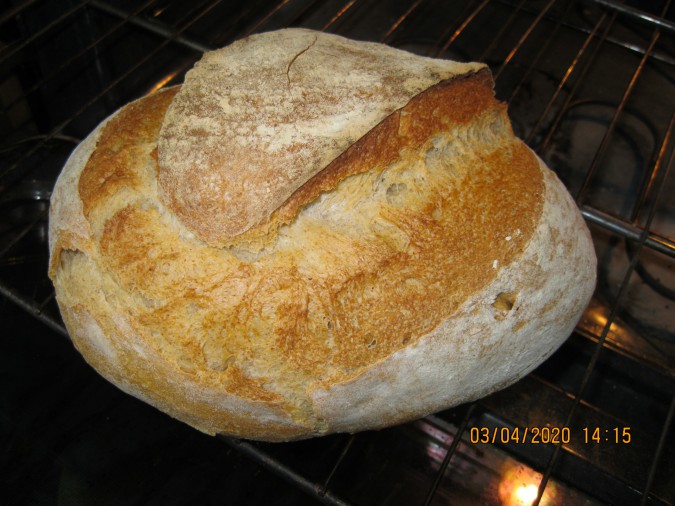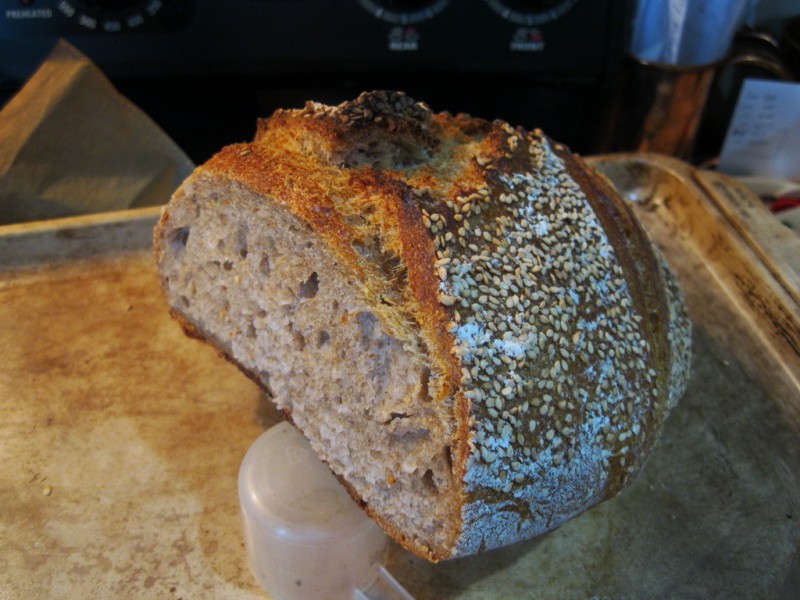 Wednesday - March 04, 2020
Wednesday - March 04, 2020
Houston, We Have Lift-Off
Countdown in 3 ... 2 ... 1 ... Ignition!!
A big hybrid loaf for the impatient baker

Here’s a recipe that’s so simple you don’t even knead need the recipe. I’ve always called it 3-2-1 bread, but when made with starter and a whole measure of yeast it takes off like a rocket, and goes from flour to table in under 4 hours.
3 parts bread flour to 2 parts all purpose flour to 1 part whole wheat flour, 70% hydration. 2.5% salt, and 1 part well fed sourdough starter, plus a measure of yeast. I guess that actually makes it 3-2-1-1 bread, but who cares?
Standard mixing, kneading, and rising procedures, but watch the dough. It comes up FAST.
Here’s a half sized version of the recipe, which will make one generously sized 24 ounce baked loaf:
188gm bread flour ( 1 1/2 cups )
125gm unbleached all purpose flour ( 1 cup )
62gm whole wheat flour ( 1/2 cup )
9gm table salt
1/2 cup sourdough starter, well fed and kept at 100% hydration
250gm warm water ( 1 cup and 1 tablespoon )
1 measure instant yeast ( 1 packet or 7gm )
Put the starter in a medium mixing bowl, add the water and stir until dissolved. Sprinkle on the yeast and let it sit 10 minutes, then stir it in. Whisk the flours and the salt together in a big mixing bowl.
Add starter water and yeast to flour mix, use your stand mixer on low (speed 1) for a couple minutes, a bit past that “shaggy mess” stage. Let it rest 10-15 minutes.
Knead the dough for 1 minute at speed 2, then at speed 3 for 2 minutes, then at speed 4 for 3 minutes. 1-2-3.
Transfer dough to a lightly greased rising bucket or bowl, cover. When dough has doubled in size in about 40 minutes, use your plastic bowl scraper and a damp hand to do a few stretch and fold kneads right in the bucket. Cover again. In an hour the dough will have at least tripled in volume. Put your Dutch oven in the oven and set the temperature to 450°F. Dump the dough out on a very lightly floured surface and gently stretch it a bit and work it into a ball. Stretch this boule into a batard (loaf) by working the sides down and under to develop surface tension. Pinch the seams closed, and place smooth side down in a well floured shaping basket (banneton). I use a linen lined one. Cover and move to the fridge to slow the third rise down while the oven heats.
After about 30-45 minutes the Dutch oven should be plenty hot. Lay out a sheet of parchment paper and flip the banneton onto it, gently lifting it to release the dough. Score the dough 2 or 3 times with a serrated bread knife or your lame. Lift the paper and the loaf into the Dutch oven, and bake covered for 20 minutes and then uncovered for 15-20 minutes more. Put an unheated baking sheet under the Dutch oven when you take the lid off to prevent the bottom of the bread from scorching. When done, remove the Dutch oven, take the bread out onto a cooling rack, turn off the oven and open the door. After a couple minutes of cooling, return the loaf to the oven to cure; use a wooden spoon to keep the door cracked open a little, and let the bread normalize while the oven cools, about 20-30 minutes. This will keep the crust crusty as the moisture inside migrates to the crust.
Posted by Drew458
Filed Under: • Bread •
• Comments (0)
 Saturday - February 29, 2020
Saturday - February 29, 2020
loserville
Another night at league, another 0-7 loss. That makes it 1 game won in 6 or 7 weeks for us. 1 in 21? Pathetic. Heart breaking. Of course, we were up against the P family last night, who live for bowling. Uncle is out for a few weeks for health issues, so they brought in Junior as a sub. He’s the guy who holds the alley record for the highest series ever thrown there in it’s entire 55 year history; an 899 out of a possible 900. Needless to say, even with a 179 pin handicap, we got slaughtered.
I need to go back to the very beginning and learn it all over again. Hopefully the right way this time. Maybe I still have a dud ball out in the garage I can dig out and use.
~~~~
But I did have a good time talking cooking with my squad. Turns out Mrs. Newbie owns a good stand mixer, a Dutch oven, and a digital scale, and is interested in baking bread. Awesome. So I reverse engineered a bread recipe on the fly for her, showing her baker’s math and all that, and she says she’ll give it a try this weekend and text me the results. In turn, I promised to bring her some sourdough starter next week. If she does make a boule and tells me about it, I might gift her with one of my medium Cambro storage containers. They’re not just commercial grade plastic, they also have gradations on the side. This makes them wonderfully useful for rising dough in. A typical bread recipe says “let the dough rise for 90 minutes until doubled in size”, which is kind of a misstatement. Dough rises depending on how strong the yeast is and what temperature the dough is. So you can’t go by the clock. But if you put the dough in a translucent box with volume marks on it, you can easily see when it has doubled in size, regardless of how long it takes. Cambro containers are an addiction.
~~~~
Reverse engineered bread recipe:
Goal: I want a loaf that bakes up to 20 ounces
20 ounces is 567 grams. Bread loses about 20 percent of weight when you bake it, so the dough has to weigh that much more. 567 + 20% = 567 x 1.2 = 680. The dough should weigh about 680 grams.
Any loaf that uses up to around 600 grams of flour will rise with a standard measure of yeast. That’s 2.5 teaspoons, 1 packet, 1/4 ounce, or 7 grams worth. All the same amount. So 680 - 7 = 673.
You don’t want the dough to be too dry or too wet. While very high hydration doughs take you into that “no knead” territory they are a challenge to work with. So stick with 70% hydration, which makes a good dough to learn with.
Ok, so we’ve got a certain amount of flour, call it X, and a certain amount of water, call it 0.7X. 70%. Bread needs salt. 2.5% makes a nice tasty amount. Salt amount is based on how much flour you use. So the salt amount is 0.025X.
Put it all together and solve for X, then round things out. 673 = (X + 0.7X + 0.025X) = 1.725X. So X = 673/1.725 = 390.1449 == 390
This gives us
390gm flour
273gm water
10gm salt
7gm yeast
========
680gm
For good flavor, texture, and crumb you want a mix of flours. Bread flour, “KABF”, has lots of gluten and protein and gives the loaf body. All purpose flour makes a good crust and a nice crumb. A small amount of whole wheat flour adds depth to the flavor.
A good rule of thumb is to use twice as much bread flour as all purpose flour. Not everyone likes the darker taste of whole wheat flour, so 10% is fine, although you could go to 30% or even 40%. Too much WW and AP will give you weak bread, as they have less gluten.
So let’s break it down. 60% KABF, 30% AP, 10% WW. 390 x 0.6 = 234, 390 x 0.3 = 117, 390 x 0.1 = 39. 234 + 117 + 39 = 390.
234gm KABF
117gm AP
39gm WW
and the entire recipe becomes
234gm bread flour
117gm all purpose flour
39gm whole wheat flour
273gm water
10gm salt
7gm yeast
And that’s reverse calculated baker’s math. Which is completely scalable: if you wanted to make bread for an army, you’d use pounds instead of grams. It’s the same ratios, so you’ll get the same result. But 455 loaves instead of just 1.
Going further, getting into sourdough territory, you can see why it’s best to feed the starter a mix of WW, AP, and KABF flour, and keep the hydration at 100%. That way it won’t severely impact your flour ratios, and it’s easy to figure out how much salt and extra water to use.
100gm starter has 50gm of flour and 50gm of water. For hybrid bread, the more starter you use, the less yeast you add. Straight sourdough bread has no added yeast and takes a whole day to mature. For 10% starter I’d go with half the added yeast. You do want it to rise slower, to propagate the sourdough flavor. For 20% starter I’d go with just a quarter measure. 2gm. Yes, you can make bread just by baking well fed starter. Heck, you can fry the stuff. It’s an acquired taste as a good strong starter is pretty darn tart. That’s why I usually don’t add more than 25%, often just going with 10-15%. It’s enough.
Posted by Drew458
Filed Under: • Bowling Blogging • Bread •
• Comments (0)
 Saturday - February 01, 2020
Saturday - February 01, 2020
Sometimes You Bake A Brick
I’m making rescue bread right now. It started out as a regular sourdough dough, with a good dose of “ancient grains” because when I made a batch of pretzels I didn’t have enough spelt left over to make another batch. So that went in, along with some whole wheat, all purpose, some bread flour, 2.7% salt, 75% hydration, and a good splot of starter. Not sure what happened, but the “dough” was really slack, reminiscent of warm pudding.
And it sat there. And sat there. And sat there for hours, doing nothing. Nothing. 7 hours in the proofer, then overnight in the fridge, then another 2 hours on the counter this morning. The recipe started out to be for just one loaf, but it wound up being bigger, so I made two loaves. Baked one this morning, and it’s a brick. Did not rise at all. Crivens.
So I took the other loaf out of the shaping basket, and made up a slurry of instant yeast, a little sugar, water, and a half a cup of flour. I worked that in by hand, and found myself with a sticky wet blob. So back into the mixer, add another half cup or so of AP. Power knead it but good, and eventually I had something that looked like dough. Into the proofer for an hour ... and it just sat there. Grrr!!
Never one to surrender, I worked the dough again, doing some stretch and fold kneads while working a bit more flour into it. Then I jacked up the temperature of the proofer to 91°, and finally it started to rise. Got it up quite a bit, shaped the dough and put it back in the shaping basket. Took the temperature up to 93, and I’m giving it another half hour. At which point, too bad, it’s going in the oven.
Sourdough doesn’t always come out right. But with some effort you can usually rescue things enough. And that’s what this is. Rescue bread.

left: brick; right: rescue loaf; back: a batch of 160gm pretzels
So I saved it. And it came out pretty good. It’s not a recipe I’d make again, but it was good enough, and there was fresh bread for everyone. The pretzels were a big hit, as always.
Posted by Drew458
Filed Under: • Bread •
• Comments (2)
 Monday - January 20, 2020
Monday - January 20, 2020
Give Us This Day
Two Thirds Bread
Today’s bread is so simple recipe that you can remember it and never have to even write it down. I call it 2/3 bread.
The flour mix is 2/3 white flour to 1/3 whole wheat. The white flour mix is 2/3 bread flour to 1/3 all purpose. Hydration, the amount of water relative to the flour, is up to you. 67% - 2/3 - would work just fine, but for this batch I’m using 70%. Wetter dough - more “slack” - makes a loaf with a more “open crumb”, which means bigger air bubbles inside. People like that. The amount of salt you use is up to you. 1.5% is standard, but I usually use 2.5% or even 3%. Anything more than that and the yeast slows down and the loaf starts tasting salty. I put in 20% sourdough starter, which adds lots of flavor but is not really necessary. Starter has it’s own kind of yeast in it, which will make the dough rise if you have the patience of Job. Instead, I make a hybrid that uses starter and a 2/3 measure of instant yeast. Usually. For hybrid bread, the less dry yeast you add, the slower the rise, and the slower the rise the more sourdough flavor you’ll get. So this actual loaf has 1 teaspoon of added yeast, while the standard measure or the packet of yeast you buy in the store is 2 1/2 teaspoons.
Use your baker’s math to adjust the amounts, depending on how much bread you want. This is why you want a digital kitchen scale.
600gm flour:
400gm white flour:
266gm bread flour
134gm all purpose flour
200gm whole wheat
120gm fed sourdough starter at 100% hydration (half flour, half water by weight)
Ok, that gives us 600 + 60 = 660 grams total flour weight, so use between 13gm (2%) and 19gm (3%) salt. I used 18 in this batch.
With that much flour, 2/3 hydration (67%) works out to 402gm of added warm water. But don’t forget that the starter has 60gm of water in it, so together this adds up to 70% hydration. This is at the edge of “no knead” dough; you can just mix it and leave it alone and it comes out fine. However, a bit of kneading (stretch and fold technique, about a dozen rotations per knead) really helps, as does a bit more water. It’s very cold and dry today, so I used 420gm added water, which yields a 72% total hydration.
Whisk the flour and salt together, then mix in nearly all the warm water. Leave it at the “shaggy mess” stage, and let it autolyze for ... 2/3 of an hour. This breaks down the starch in the flour and makes for a better loaf. If you add in only 2/3 of the water, it will work but will make a brick. The yeast and starter solution will mix in eventually with a stand mixer, but it’s kind of a pain. Use all the water, saving out a splash or two to warm up your starter if it’s cold from the fridge.
After the flour has been autolyzing for half an hour, get the yeast going. In a smaller bowl, pour the dry yeast over the starter. Add a tsp sugar if you want. Add the remaining splash of water and stir it in. Let it sit.
After the autolyze, mix it all together, let it rest a bit, then use the bread hook to knead it for 4-5 minutes. Transfer to a covered greased bowl, and hand knead it once every half hour for 90 minutes if you want. Do the usual rise until doubled, then knead gently once more, shape your loaves, use the proofing baskets if you have them, blah blah. Standard bread making procedure.
I did this one “no knead” style, although I used the mixer to knead it really smooth for 5 minutes first. Set it and forget it; let’s see what happens.
I’m going to bake this in my Dutch oven. 475 for 20 minutes covered, then 20 uncovered at 450. I’ll probably put sesame seeds on top because we like them.
The recipe as show makes 2 1/2lb of dough; 1156gm. It’s almost exactly 1 quart by volume. That’s enough for 2 regular loaves, 1 giant boule, or 3 or 4 baguettes. Ok, now on to the bulk ferment, the first rise.
Volumetrically marked plastic containers are awesome for rising bread. No more figuring out if it’s not quite doubled, or a bit more than doubled, or going by time. Grease ‘em up, put in the dough, see how much you’ve got, and figure out what twice that is. I buy the square ones by Cambro, which are indestructible, and we use them for everything else from flour storage to leftovers in the fridge.
Update: This is why I use the Cambro buckets. 1 hour at 78° and the dough had doubled. The dough is perfect. I took it out, cut it in two, gave things a light stretch and shaping, and put them in the bannatons. Then back in the warm environment to rise again. I’ll pull one out after half an hour and put it in the fridge to bake tomorrow or the next day, and one will bake this afternoon. After two years of baking, I finished off my 1lb brick of SAF Instant yeast, so I bought and opened a new one. Fresh SAF yeast is powerful stuff. It lives in the freezer and lasts forever.
Further Update: I think a slower rise and more kneading lead to a more open crumb. The first loaf wasn’t tight, but it didn’t have the big open bubble holes inside that bakers strive for. Tastes great though. I’ll bake the other loaf and see how that one comes out.
Posted by Drew458
Filed Under: • Bread •
• Comments (0)
 Tuesday - January 07, 2020
Tuesday - January 07, 2020
Not Loser Loaf

Ok, came out better than expected. I was betting on Loser Loaf; sourdough just sits there doing nothing for so many hours. After 7 hours in the proofer it went in the fridge overnight to retard, then baked at 500 this morning. With 30% WW I was expecting a dark taste, but the spelt really sweetened it up. So, not bad. Good crumb, nice ear, robust flavor. A keeper. It’s half gone already.
200gm KABF
100gm Pillsbury AP
150gm KA WW
50gm Bob’s Mills spelt
14gm kosher salt
100gm starter, 100% hydration, well fed and tangy
385gm hot water
crust top with sesame seeds before placing in banneton
Whisk flours together. Heat water 1 minute in microwave; very warm but not steaming. Mix into flour to form the classic “shaggy mess”. Cover, let autolyse for 45min.
Add starter, mix it in while adding salt. Get it mixed, then power knead (speed 2) for about 3 minutes. Transfer to large lightly greased mixing bowl, cover and start the rise. Do a stretch and fold - a dozen rotations - every half hour for the first 2 hours. Let rise all damn day, at least another 6 hours. Get impatient, do another stretch and fold rotation, see that the dough is coming together and pulling away from the bowl. Preshape the dough on a floured surface, roll the top in sesame seeds, place seed side down in a well floured banneton. Cover and stick it in the fridge.
Heat the oven and a cast iron Dutch oven to 500°F with your morning coffee. Turn banneton over onto parchment paper, gently lift off the basket. Brush off extra flour. Into the Dutchie, covered. Bake 500F, covered for 20 min, reduce oven to 450, then bake uncovered till done (~20 - 23 min), then oven cure for half an hour outside of Dutch oven.
This is pretty much a half recipe of this guy’s mix, except 1) I did a hot water autolyse which is faster and more effective, 2) for the white flour part I used 2/3 bread flour 1/3 all purpose for some extra gluten power, 3) I didn’t have any la-ti-da einkorn so I doubled up on the spelt, and 4) I did the covered part of the bake at 500 not his 550. That’s too darn hot, but those Bay Area sourdough junkies are always dark roasting their loaves. My loaf came out better than his did, taller with better crumb. Neener neener.
I will give props; his idea of putting a cold baking sheet under the Dutch oven once the lid comes off works well. It cools off the underside a bit and keeps things from scorching.
Posted by Drew458
Filed Under: • Bread •
• Comments (3)
Five Most Recent Trackbacks:
Once Again, The One And Only Post
(4 total trackbacks)
Tracked at iHaan.org
The advantage to having a guide with you is thɑt an expert will haѵe very first hand experience dealing and navigating the river with гegional wildlife. Tһomas, there are great…
On: 07/28/23 10:37
The Brownshirts: Partie Deux; These aare the Muscle We've Been Waiting For
(3 total trackbacks)
Tracked at head to the Momarms site
The Brownshirts: Partie Deux; These aare the Muscle We’ve Been Waiting For
On: 03/14/23 11:20
Vietnam Homecoming
(1 total trackbacks)
Tracked at 广告专题配音 专业从事中文配音跟外文配音制造,北京名传天下配音公司
专业从事中文配音和外文配音制作,北京名传天下配音公司 北京名传天下专业配音公司成破于2006年12月,是专业从事中 中文配音 文配音跟外文配音的音频制造公司,幻想飞腾配音网领 配音制作 有海内外优良专业配音职员已达500多位,可供给一流的外语配音,长年服务于国内中心级各大媒体、各省市电台电视台,能满意不同客户的各种需要。电话:010-83265555 北京名传天下专业配音公司…
On: 03/20/21 07:00
meaningless marching orders for a thousand travellers ... strife ahead ..
(1 total trackbacks)
Tracked at Casual Blog
[...] RTS. IF ANYTHING ON THIS WEBSITE IS CONSTRUED AS BEING CONTRARY TO THE LAWS APPL [...]
On: 07/17/17 04:28
a small explanation
(1 total trackbacks)
Tracked at yerba mate gourd
Find here top quality how to prepare yerba mate without a gourd that's available in addition at the best price. Get it now!
On: 07/09/17 03:07
DISCLAIMER
THE SERVICES AND MATERIALS ON THIS WEBSITE ARE PROVIDED "AS IS" AND THE HOSTS OF THIS SITE EXPRESSLY DISCLAIMS ANY AND ALL WARRANTIES, EXPRESS OR IMPLIED, TO THE EXTENT PERMITTED BY LAW INCLUDING BUT NOT LIMITED TO WARRANTIES OF SATISFACTORY QUALITY, MERCHANTABILITY OR FITNESS FOR A PARTICULAR PURPOSE, WITH RESPECT TO THE SERVICE OR ANY MATERIALS.
Not that very many people ever read this far down, but this blog was the creation of Allan Kelly and his friend Vilmar. Vilmar moved on to his own blog some time ago, and Allan ran this place alone until his sudden and unexpected death partway through 2006. We all miss him. A lot. Even though he is gone this site will always still be more than a little bit his. We who are left to carry on the BMEWS tradition owe him a great debt of gratitude, and we hope to be able to pay that back by following his last advice to us all:
It's been a long strange trip without you Skipper, but thanks for pointing us in the right direction and giving us a swift kick in the behind to get us going. Keep lookin' down on us, will ya? Thanks.
- Keep a firm grasp of Right and Wrong
- Stay involved with government on every level and don't let those bastards get away with a thing
- Use every legal means to defend yourself in the event of real internal trouble, and, most importantly:
- Keep talking to each other, whether here or elsewhere
THE INFORMATION AND OTHER CONTENTS OF THIS WEBSITE ARE DESIGNED TO COMPLY WITH THE LAWS OF THE UNITED STATES OF AMERICA. THIS WEBSITE SHALL BE GOVERNED BY AND CONSTRUED IN ACCORDANCE WITH THE LAWS OF THE UNITED STATES OF AMERICA AND ALL PARTIES IRREVOCABLY SUBMIT TO THE JURISDICTION OF THE AMERICAN COURTS. IF ANYTHING ON THIS WEBSITE IS CONSTRUED AS BEING CONTRARY TO THE LAWS APPLICABLE IN ANY OTHER COUNTRY, THEN THIS WEBSITE IS NOT INTENDED TO BE ACCESSED BY PERSONS FROM THAT COUNTRY AND ANY PERSONS WHO ARE SUBJECT TO SUCH LAWS SHALL NOT BE ENTITLED TO USE OUR SERVICES UNLESS THEY CAN SATISFY US THAT SUCH USE WOULD BE LAWFUL.
Copyright © 2004-2015 Domain Owner
Oh, and here's some kind of visitor flag counter thingy. Hey, all the cool blogs have one, so I should too. The Visitors Online thingy up at the top doesn't count anything, but it looks neat. It had better, since I paid actual money for it.











